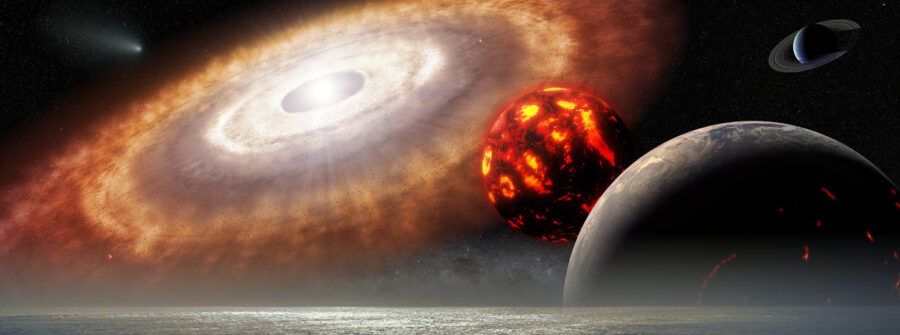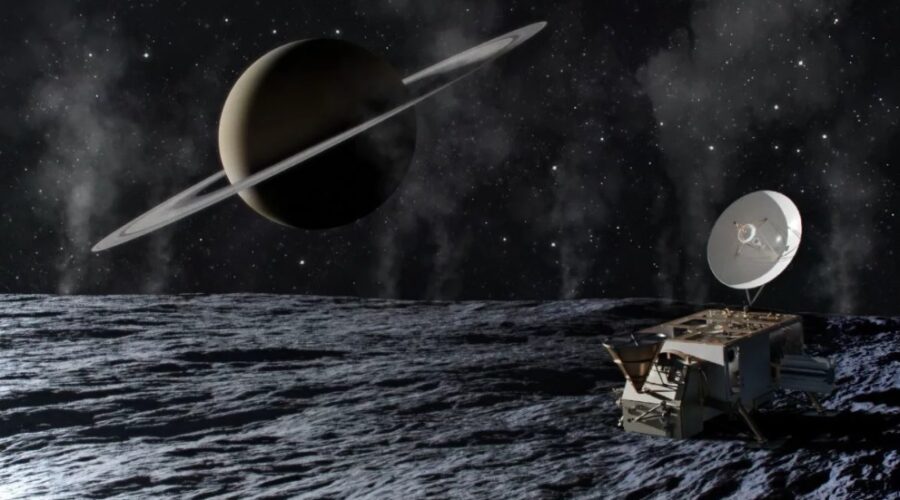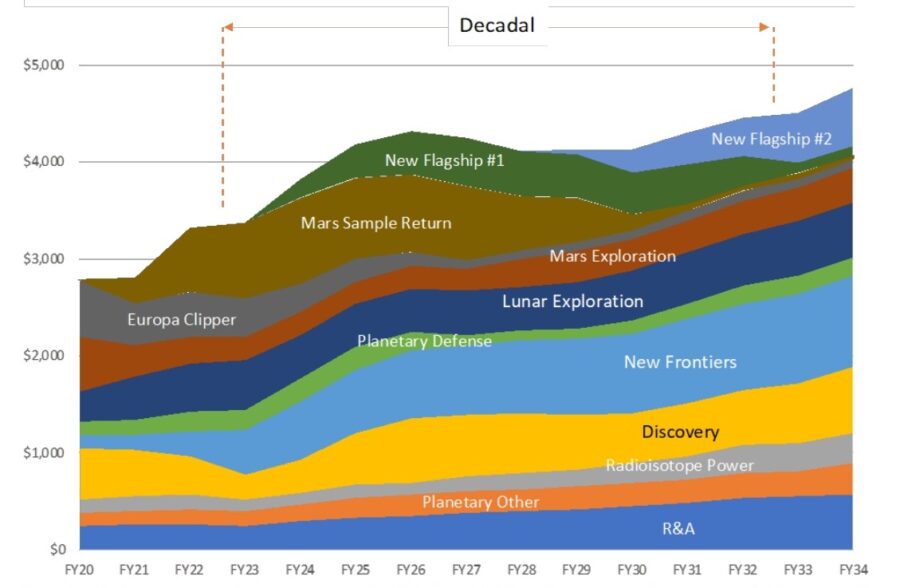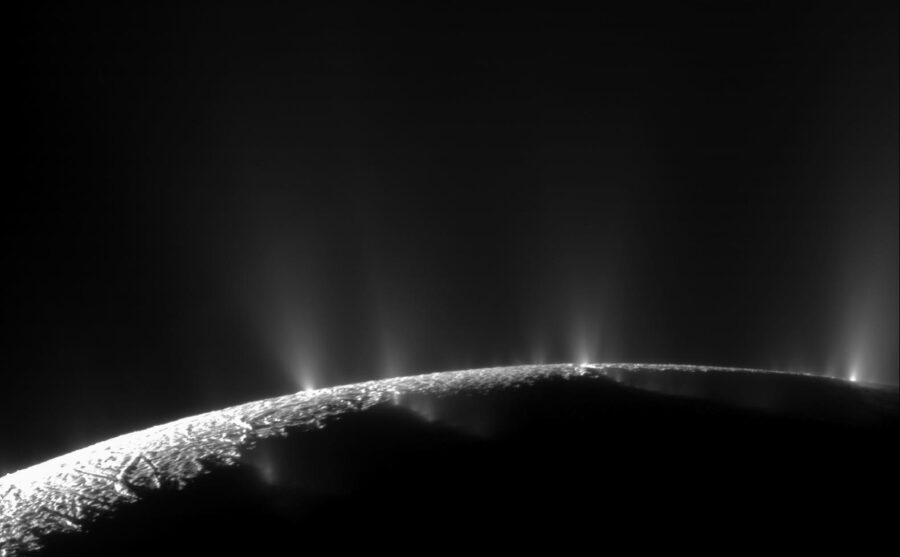Big winners in a community survey that helps determine the next decade of planetary science include a Uranus flagship mission, a mission to Enceladus, and planetary defense.

The National Academies of Sciences
It’s out. The planetary science community has released a report outlining a vision for the next decade. This decadal survey, the result of years of steering committees, white papers, advisory groups, and conferences, represents the marching orders for NASA's (and to some extent, NSF's) next 10+ years of planetary — and exoplanetary — exploration.
The National Academies of Sciences' Planetary Sciences and Astrobiology Decadal Survey, titled Origins, Worlds and Life: A Decadal Strategy for Planetary Science and Astrobiology 2023-2032, is the third prioritized wish list of its kind. As always, any mission concepts will still need to go through rounds of funding, design, and development before reaching the launch pad.
The Last Decadal
A look at the last decadal survey, entitled Visions and Voyages, shows the influence of these efforts can have. That report listed as top priority a Mars astrobiology explorer and sample-caching mission, which became the Perseverance rover that's currently exploring Jezero Crater on the Red Planet. Perseverance is setting aside samples as the first step of the Mars Sample Return initiative, for which the return vehicle will launch in the 2026 launch window. The decadal's second priority, a Europa orbiter mission now named the Europa Clipper, is set to launch in 2024.
Visions and Voyages also set themes for smaller missions, categorized by NASA as New Frontiers and Discovery-class missions. Those themes ultimately led to the selection of Dragonfly, a nuclear-powered helicopter that will head to Saturn’s moon Titan in 2027, the Lucy and Psyche asteroid missions, as well as the DAVINCI and VERITAS Venus missions set to fly later this decade.
This Year's Champions
Besides continuing development and support of these projects, the newest decadal survey prioritizes a few large exciting mission concepts.
As the top-priority new flagship mission, which by definition has a budget more than $1 billion, the report recommends the Uranus Orbiter and Probe. This would be a large, Cassini-style mission to the ice giant and its moons and will include a probe that will enter the atmosphere. To date, we’ve only seen Uranus up close once, during the brief Voyager 2 flyby in 1986. Uranus won out over Neptune due to the flexibility of existing launch vehicles and technology for a 2031 to 2038 launch window, with a Jupiter-flyby assist.

NASA / NRC Decadal Survey
The second-highest priority among flagships is a combination orbiter-and-lander that would head to Saturn’s moon Enceladus, referred to in the report as the Enceladus Orbilander. This moon is a dynamic world with a subsurface ocean that that may contain the complex processes needed to host life. Cassini caught sight of plumes emanating from ice geysers during several flybys, and Enceladus Orbilander could sample these and study the moon’s surface up close.
Four other flagship concepts that were in the running were a Europa lander, a Mercury lander, a Neptune/Triton mission, and a large mission to Venus.

NASA
As guiding principles, the survey identifies 12 top scientific questions under three key themes: origins, worlds and processes, and life and habitability. These questions, which cover everything from how giant planets form to the whether we'll find life beyond Earth, will help shepherd mission selection.
"I think [the decadal] is a very compelling vision for space exploration for the next decade and beyond," says Jonathan Fortney (University of California, Santa Cruz). "I think it is a great mix of getting new data from some of the hottest areas, and essentially new exploration and reconnaissance."
The Role of Smaller Missions
NASA has two classes of smaller missions, of which New Frontiers offers roughly double the budget as for Discovery-class missions but at a slower launch cadence. The New Frontiers 5 selection, covered in the last decadal and originally slated for October 2022, has been delayed to October 2024.
The new decadal survey covers the next two rounds, New Frontiers 6 and 7, which will take us through 2032. Rather than recommending specific missions for these competitive selections, the report sets detailed themes for consideration:
- Centaur Asteroid Orbiter and Lander
- Ceres Sample Return
- Comet Surface Sample Return mission
- Enceladus mission with multiple flybys
- Lunar Geophysical Network
- Saturn Probe
- Titan Orbiter
- Triton Ocean World Surveyor (to be added for New Frontiers 7 only)
- Venus In Situ Explorer
The report doesn't lay out any specific themes for the Discovery program, though it does recommend that NASA should continue to select two Discovery-class missions per round. The report also recommends the cost cap for Discovery-class missions be raised from $500 to $800 million.
Really interesting discussion by co-chair Robin Canup about the role of Discovery in the #PlanetaryDecadal. Cost cap goes up by 60% to $800M, but it now includes operations costs, which makes it difficult for outer planets missions to squeeze into it (i.e. they are far away).
— Casey Dreier (@CaseyDreier) April 19, 2022
In addition, the decadal also recommends a cap increase, from $55 million to $80 million, for NASA's Small Innovative Missions for Planetary Exploration (SIMPLEx), very small, low-cost, and higher-risk projects.
For our next step on Mars, the report prioritizes a Mars Life Explorer as the next mission to be developed after the Mars Sample Return is completed.
For lunar exploration, the survey recommends the development of Endurance A, a large sample-return mission that will visit the lunar south pole. It would collect about 100 kilograms of samples (220 pounds), to be returned to Earth by astronauts as part of the Artemis initiative. The report notes that planetary science goals should be primary to Artemis rather than a side objective.
The report also cites a need for NASA to address shortfalls in funding of technology for planetary science missions, which has dropped in recent years to just 4%. To correct this and achieve the goals stated in the report, the panel recommends that NASA's Planetary Science Division increase funding to match previous levels, 6–8% of the total budget.

National Academies of Sciences
Planetary Defense
NASA's goals in planetary defense are guided by the Brown Act, which called for NASA to identify 90% of near-Earth asteroids more than 140 meters across by 2020. As of 2021, scientists have only cataloged a third of that population. The mid-infrared NEO Surveyor space telescope, already under development, will be crucial to finding more of these potentially threatening space rocks. While the forthcoming Vera C. Rubin Observatory is complementary to NEO Surveyor, it's not a substitute.
The report also calls for NASA's Orbital Debris Program Office to work with U.S. Space Command in detecting asteroids that come very near Earth. Ground-based radar and other tracking offers a chance to characterize small near-Earth asteroids, including the upcoming close pass of 99942 Apophis on April 13, 2029. The recent loss of Arecibo makes the need to upgrade tracking and the Deep Space Network especially urgent.
Diversity and Equity
In a first, this decadal survey highlights the urgent need to promote diversity and equity in the field of planetary science. “Ensuring the broadest level of participation is necessary to produce high-quality science in an environment of fierce competition for limited human resources,” the report states. “The rich and unparalleled diversity of the people in the United States is NASA’s strongest advantage, but only if such diversity is tapped by robust procedures for identification and recruitment . . . and equitable reward structures.”
To this end, the report recommends that NASA’s Planetary Science Directorate should adopt a view that bias can be often both pervasive and unintentional, and the agency should work to “eliminate bias from its procedures, wherever it is found to exist.”
The Need for Plutonium
The report also highlights the production of plutonium-238, restarted in 2013, as crucial to the future of deep-space exploration. The radioactive energy source will be needed for the Uranus and Enceladus missions, which venture too far from the Sun to use solar panels. The report recommends that NASA review the plutonium needs for a coming generation of missions and increase production if needed.

NASA/JPL/Space Science Institute
Satellites vs. Near-Earth Asteroids
Finally, the report cites the impact that the rise of satellite constellations, such as SpaceX’s Starlink, UK’s OneWeb, and Amazon’s Project Kuiper, will have on the effort to effectively search for near-Earth asteroids. The report thus calls for NASA, the National Science Foundation, and the astronomical community to continue to monitor the satellite swarms and investigate ways to mitigate their impacts on observations.
The next decade promises exciting years of planetary space exploration. I, for one, can’t wait to see a crescent Saturn above the icy horizon of Enceladus, not to mention new images of Uranus and its moons. Let's see, by 2042 I'll be . . .
 0
0








Comments
You must be logged in to post a comment.